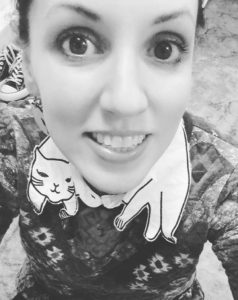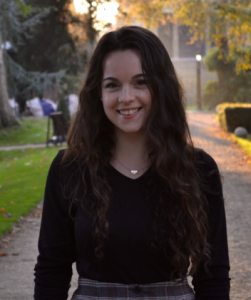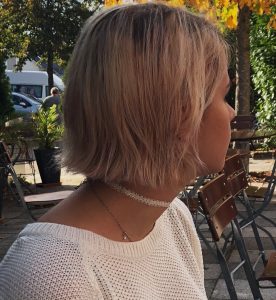
My daughter fell under the spell of fairy tales early on when, as a toddler, she watched Lady and the Tramp for the first time on a VHS tape that I’d rented at a Delaware County Blockbuster while she fought a stomach bug. She’d enjoyed the movie so much that we gifted her with Lady and Trump stuffed toys for her next birthday. Thereafter, she gradually became enamored of everything else Disney, until we got an inkling that this might be coloring her world view. We’d warned her about stranger danger as a youngster, and yet she’d extend the perkiest of hellos to folks we’d pass on the street, as Goofy might. And, as a teen, when our family visited Disney World, she’d had to be reminded to breathe as we’d embarked on Main Street USA, despite our caution that while that Main Street USA’s souvenir shops were beguiling, they were also pricey. Fortunately, even a souvenir as unexceptional as a bag of Mickey Mouse-shaped pretzels made her smile.
As a college freshman, she met a young man who was honorable and hardworking, and they fell for one another over afternoons at Linvilla Orchards or the Sproul Bowling Lanes and evenings at Friendly’s restaurant or the AMC Theater. In their mid-20s, he proposed marriage. She had officially found her prince, and they said their vows in 2013 on a bright, fall Saturday. Soon after, they found a place to live in Wilmington with copious drafts and missing shingles but a good configuration, and they slowly turned it into a home that included a Cinderella snow globe and a Mickey and Minnie alarm clock.
But these fairy tale associations would come to an end, and the beginning of the end fell on Christmas Day in 2014, when my daughter and her husband, both age 27, excitedly shared with me their desire to start a family. They’d been helping me peel our dinner potatoes in the kitchen, when she’d excitedly let slip, “Mom, we’re trying for a baby.” I saw my son-in-law blush and hugged them both. “How wonderful!” I cried out.
They spread the news to the rest of the family as we gathered in the dining room. Then, my daughter leaned toward me and whispered, “Who knows, mom? I could be pregnant already.” I nodded and put my hand in hers. We had no idea what was coming.
My daughter was not pregnant on that Christmas Day in 2014, nor was she pregnant on Christmas Day in 2015, 2016, 2017, 2018, or 2019. Instead, they were diagnosed as the one couple in eight who suffer from infertility.
In 2015, after one year without success, my daughter’s gynecologist had various recommendations, such as ovulation predictor kits and fertility monitor bracelets among others. However, no amount of calendar marking, temperature taking, or urine dip sticking resulted in pregnancy.
In 2016, they visited an infertility specialist. The hope was that medical breakthroughs would step in and solve the mystery. Coinciding with this time was a career opportunity for my son-in-law, but it required that he live out of state for a couple of months. My son-in-law didn’t want to live away even temporarily, but the Intra-Uterine Insemination (IUI) procedures they were about to begin at the Reproductive Associates of Delaware would be costly, and my daughter reassured him that a better job was for the best. It was determined that, with meticulous planning, the procedures could take place while my son-in-law was away, and that I would accompany my daughter to the infertility appointments.
Ahead of the first IUI, an exploratory surgery was performed to check for cysts or blockages. I sat in the waiting room wishing that something would be found because then something might be remedied, but the surgical results were inconclusive. The diagnosis was unexplained infertility, which doesn’t sound like a diagnosis at all, but is one, we discovered. Our drive home from the surgery center involved my getting hopelessly lost, while my daughter endured post-anesthesia vomiting in the passenger seat. Eventually, I got her settled at home with a blanket on the sofa, unearthed old coloring books and crayons, ordered a pizza, and then slipped Mulan into the DVD player, and there we sat for hours.
In July of 2017, I held my daughter’s hand as she underwent IUI #1. Post-procedure, the doctor left the room while my daughter and I remained for a recommended 20-minute period of lying supine. In the sterile environment, I rubbed her stomach to soothe her and decided to sing Hap Palmer’s My Mommy Comes Back, her favorite childhood song. She laughed and shushed me, but I saw tears slip from her eyes, so I continued. I sang dreadfully but hoped it would generate good luck. Then, two weeks later, when we returned to the doctor’s office, her pregnancy test was negative.
In September of 2017, we were back at the Reproductive Associates of Delaware, ever hopeful, as my daughter underwent IUI #2. “The odds are better the second time around,” the doctor opined. This didn’t seem logical, but my daughter lit up, so I nodded and said, “Well, here we go then!” As she laid on the table afterward this time, I didn’t sing, but I dug deep for words of comfort as she closed her eyes. We’d brought along what we hoped were good luck charms – a photo of her as a baby in my pocket and a prayer bead bracelet on her wrist. Two weeks later, we returned for her pregnancy test, and once again, there was no pregnancy. We traversed the parking lot as she sobbed.
Then my son-in-law returned home from training. He was assigned employment in New York, and we all did our best to focus on that instead of on the IUI failures. We threw them a going away party with decorations and gifts for their new place in Queens. No one mentioned babies. Instead, we spoke of the excitement of the Big Apple. It was a fresh start.
They signed on with The New York Fertility Center in Flushing. Other than adoption, their last-ditch effort was looming, namely In-Vitro Fertilization (IVF). Their leadup to IVF was chockfull of doctor appointments, injections, and medications. They needed to create a poster board to keep track of everything. There were injections of Gonal, Menopur, Ganirelix, Progesterone in Oil, and Ovridrel. The drugs included Letrazole, Medrol, Estrace, Zithromax, DHEA, CoQ10, and Prenate. After weeks of prep, the doctor inserted a needle into my daughter’s ovarian follicle and retrieved six eggs. Those eggs were placed in a culture dish, where sperm was waiting.
My husband and I visited them the following weekend. We explored Queens for hours, but mostly listened for a call from the doctor to learn how many of the six eggs had been fertilized. When the call finally came, the doctor reported that two eggs had been fertilized excellently, two acceptably, and that two were not viable. The four useable embryos would be allowed to remain in the culture dish until they became blastocysts, about five days post-fertilization. It was decided that the two excellent blastocysts would be transferred to my daughter’s uterus, while the two acceptable ones would be frozen for future use.
IVF #1 took place in April 2018. The injections and medications continued, and they were scheduled to return to the doctor’s office in two weeks for a pregnancy test. That day, my daughter phoned me from the doctor’s parking lot in a downpour, “I’m spotting, mom, there’s a discharge, so I guess I’m not pregnant,” she despaired, her fast-moving windshield wipers delivering a background whoosh. However, the news they received was just the opposite. They were pregnant! The doctor said that a discharge can be normal, and implantation is often the cause. I wanted to hoot and holler with joy but found that I was paralyzed with fear. There was so much at stake.
In the weeks that followed, our family and my son-in-law’s family hoped, prayed, and begged for a viable pregnancy. My husband visited his father’s grave to ask for this one favor, this one blessing, if possible. The waiting was terrible, but something that we would bear gamely, if it resulted in a healthy pregnancy.
Yet, on the Friday of Memorial Day weekend, 2018, they suffered a miscarriage. The discharge had increased. It had not been from implantation, but had been a slow breakdown of the implanted blastocyst. Afterward, they drove from NY to the NJ shore to spend the rest of the holiday weekend with family in Brigantine, where my mother owns an always-crowded, but much-loved, 1950’s era bungalow. We sat on the weathered porch and waited for my daughter and son-in-law to arrive, and when they did, everyone went inside to console them.
IVF #2 took place in July 2018. The two frozen blastocysts were thawed and then transferred. For this go-round, my daughter took a leave of absence from work in the hope that being inactive would boost their chances. After two weeks, they returned for a pregnancy test, and once again, it was positive. I tried my best to slay negative thoughts. There was no discharge. How could there be back to back miscarriages? It was finally their turn, wasn’t it?
At four weeks of pregnancy, my daughter and son-in-law had their first ultrasound. There wasn’t much visible on the screen, but the technician called this normal, so we sighed in relief. My husband and I visited them again in Queens, bringing grocery bags filled with healthy food and drink. The desire to do something helpful was palpable.
At five weeks, an ultrasound showed a yolk sac — great news — but a fetal pole was to be expected and was not there. The technician said, “No worries, the fetal pole will probably be found next time.”
The next ultrasound was scheduled for the following week. We wanted to jettison the days that stood in between.
At six weeks, we learned the fetal pole was visible. Once again there was a caveat. My daughter told us, “They did expect to see the heartbeat today too, but they didn’t, and so they hope to detect it next week.”
At seven weeks, a miniscule heartbeat was seen on ultrasound. It was termed a”flicker.” Then, another caveat, “We should also hear the heartbeat, however,” the technician said, but added, “let’s see what we’ve got next week.”
But what they heard the next week was not the sound of a heartbeat. Rather, it was the sound of the technician’s voice letting them know that the “flicker” had vanished.
It was the beginning of the Labor Day weekend, as fate would have it, and another miscarriage was diagnosed. This time, an examination of the uterine contents revealed a female embryo with an extra chromosome that would have led to serious birth defects. After resting for a day, my daughter and son-in-law joined family once again at the bungalow in Brigantine. Like before, we waited for them on the porch. That evening over dinner, we talked about how their miscarriages had bookended the summer of 2018—Memorial Day weekend and Labor Day weekend. It was a summer we were eager to put to rest.
As I write this, 2020 has just begun, and my daughter and son-in-law remain childless. Following the IVF procedures and failures, they decided to try for adoption. They met in early 2019 with a NY adoption lawyer, who gave them loads of advice, but no distinct path to finding a child to adopt. The lawyer explained that couples today advertise in order to locate potential birth mothers. We found this unusual until some Internet investigating proved it to be true. The lawyer also explained that my daughter and son-in-law would first need to become NY-certified adoptive parents. The process took six months to complete. The contents of a packet that was placed before a NY judge and scrutinized included employment and financial records, background checks, fingerprinting reports, and a home study report by a licensed social worker. Their marital relationship and mental health were studied, and queries responded to about extended family. Today, my daughter and son-in-law have created a website, as well as social media accounts, all of which endeavor to encapsulate who they are and the unconditional love that they long to share with a child. They’ve designed and printed postcards that communicate their desire to adopt, and they’ve placed ads in church bulletins. Thus far, their luck hasn’t changed, but they tell us they remain more devoted to one another than ever, a silver lining. They now have two nephews and can often be found building Lego towns with them or treating them to Disney on Ice and Paw Patrol Live.
While the physical and emotional hardships are unmistakable, there is another hardship that bears mentioning, and that is the financial toll of infertility. Treatments are not covered by the majority of insurance plans. IUI procedures can run from $2,000 to $4,000 each, inclusive of pre-testing, medications and follow up. My daughter and son-in-law were able to use savings for their two IUI procedures, but for IVF, they were forced to use credit cards. The cost of the two IVF cycles they underwent was $17,500. They opted for the “special rate,” which meant they signed on for two IVF cycles from the get-go. Credit card bills of that heft are not paid off quickly or easily. Moreover, the monthly credit card statements are a reminder of what might have been.
My daughter and son-in-law tell us that everything they’ve gone through will be worth it when they finally bring home a child, no matter how it happens. As for me, I imagine that day, picturing my husband and me showering our future grandchild with kisses. I can almost see it: my daughter leaning toward me to whisper, the same way she did on Christmas in 2014 when everything started. Only this time, she will say, “Mom, can you believe we have a baby?”
Nancy Farrell is a lifelong writer with a focus on autobiographical works. She works as a legal assistant in Media, PA. If you would like to connect with the couple featured in “A Non-Fairy Tale” about your own infertility struggle or if you are considering giving up a child for adoption, feel free to visit http://www.mandmadopt.com.









